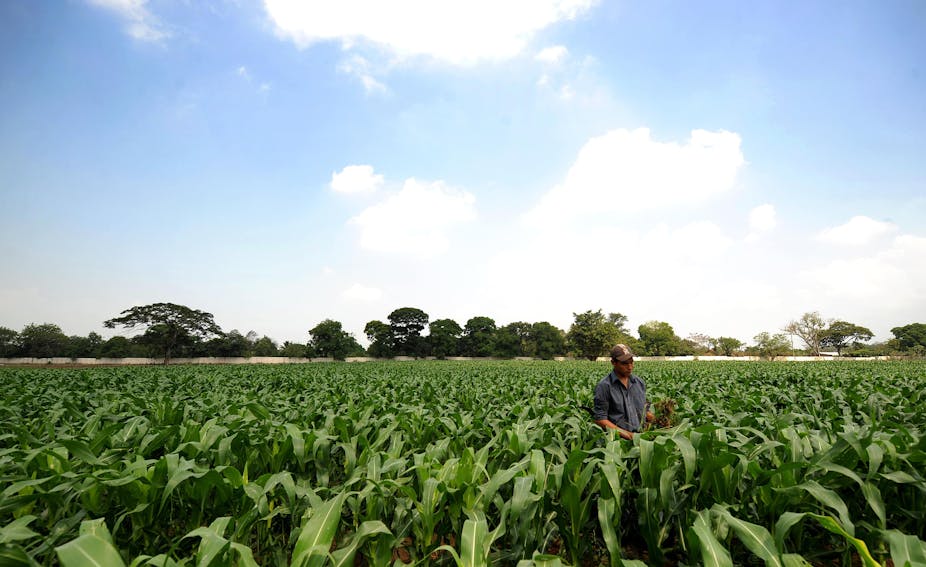Life is woven out of air by light – Jacob Moleschott
Before starting to write this article, I asked my eight-year-old boy what he knew about how plants grow.
He answered: “Plants take food from the air and use the sun to grow”. He was pretty right: CO₂ is food for plants, though CO₂ is also a pollutant.
Having some CO₂ in the atmosphere can be a good thing, as it provides us with warmth through the greenhouse effect. At the same time it is the source of carbon for plants on Earth.
Laboratory studies have shown that having more CO₂ in the air will increase the rate of photosynthesis and growth for most temperate plants, if they have enough water and nutrients. This is called CO₂ fertilisation.
This is because photosynthesis in plants such as wheat, rice, and soybean is source limited. Quite simply, “source limited” means that at present concentrations of atmospheric CO₂ (approximately 380 parts-per-million), photosynthesis rates are running at about ¾ of full capacity.
The leaves of summer crops (such as maize and sorghum) work differently, and they are less responsive to increases in atmospheric CO₂.
But in real life – “out in the field” – things can be dramatically different. There is much more to climate change effects than just CO₂ fertilisation. More on that in a moment.
Can one desire too much of a good thing?
Sometimes too much of a good thing can be a bad thing. This is particularly the case with greenhouse gases such as CO₂.
As levels of CO₂ increases in the atmosphere, air temperatures increase and global and regional climate patterns change. This has serious implications for the functioning of most biological systems.
Recent CO₂ atmospheric measurements indicate we are already overshooting safe climate targets, with important implications for our climate systems.
In Australia, evidence indicates feedback processes are likely to increase the frequency of El Niño events.
In Australia, El Niño events are linked with widespread droughts, heat waves, and bush fires. From 1902 to 2002 we had 24 El Niño events, of which 62% occurred after 1950. Between 1990 and 2002 there were six such events.
At this point I think we can all agree that CO₂ is both a food for plants, and a dangerous pollutant.
So what does this mean in terms of the potential for our planet to feed a growing population by 2050?
Does more CO₂ mean more to eat?
When we think about the growth of plants and how much they yield, CO₂ fertilisation and climate change will have different effects. There is also a difference between climate change impacts on crop yields and on the profitability of farm businesses.
One third of the world’s food is produced by determinate crops grown on smallholder farms in the developing world. Determinate crops are ones that bear their full yield at once. These are crops such as wheat, rice, maize and beans that die after a few months in the ground, after which their full yield is harvested.
The yield is a fraction of the total growth of the crop – from 0-50% – and depends on whether the crop faces serious water or heat stresses.
CO₂ fertilisation has a positive effect on crop growth. But climate change will affect both the fraction of the crop that is harvestable, and the total growth of the crop.
Heat, water and CO₂: it’s a complex package
Increased air temperatures are expected to expose crops to more very hot days. This will damage developing grains and reduce the harvestable yield.
Crops will need more water and will face water shortages more often. Increased temperatures mean the time from sowing to harvest will be shorter, so crops will grow less and have smaller yields.
Water is key in crop growth and production: 80% of the total agricultural land depends on rainfall. Changes in precipitation are likely to have fundamental impacts on food production.
Analyses of recent trends in global food production could be the best indicator of how climate change will affect global food production in future. One analysis shows that since 1980, higher CO₂ and climate change have had a slight positive effect on rice and soybean, and a negative effect on wheat and maize.
In Africa, maize is the main food staple. Researchers calculated that 1°C of global warming would reduce yields across the continent by 20% over 75% of the area if there is drought. Under optimal management, 1°C of warming would reduce maize yields by around 10% on 65% of the area.
It’s not all bad news
The challenges are significant, but we should be able to feed 9 billion people by 2050. Over the last 50 years the increase in agricultural production fed an additional 4 billion people with only an 11% increase in land area.
In Brazil there has been sustainable intensification of broad acre agriculture. Vietnam has changed its regulations on land ownership. Malawi has introduced smart subsidies on agricultural inputs.
Nowadays Brazil is leading the world as a global net food exporter; smallholder farmers from Vietnam are increasingly accessing international markets; and Malawi, one of the poorest countries in the world, exports maize to neighboring countries.
These are significant, if small, examples of how the right technologies and policies can generate incentives, opportunities and economic growth from agriculture, whatever our climate future holds.
So, is CO₂ just plant food? Or is it just a pollutant? As with all of these things, the answer is: “it depends”.

